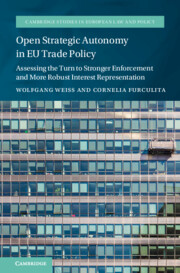 Open Strategic Autonomy in EU Trade Policy
Open Strategic Autonomy in EU Trade Policy In Tension with EU’s International Trade and Climate Commitments
from Part III - The Tools for Assertive Representation of EU Interests
Published online by Cambridge University Press: 29 November 2024
Chapter 10 focuses on the EU’s Carbon Border Adjustment Mechanism (CBAM), introducing carbon pricing on imported products from certain sectors, in an attempt to address carbon leakage and, intentionally or not, ensuring a level playing field between domestic and imported products. The chapter presents the mechanism, its aims, and its consistency with EU’s international environmental and trade commitments. Accordingly, the chapter analyses the question of CBAM’s compatibility with the international principle of common but differentiated responsibility (CBDR) as it treats developing and least developed countries on an equal footing with the developed ones. Then it considers the question of the mechanism’s compliance with WTO rules, in particular WTO non-discrimination rules and prohibition on quantitative restrictions. It pays special attention to potential justifications of possible breaches and whether they could accommodate also a CBAM in line with the CBDR principle, thereby addressing the convoluted question of the relationship between international trade and climate regimes.
To save this book to your Kindle, first ensure [email protected] is added to your Approved Personal Document E-mail List under your Personal Document Settings on the Manage Your Content and Devices page of your Amazon account. Then enter the ‘name’ part of your Kindle email address below. Find out more about saving to your Kindle.
Note you can select to save to either the @free.kindle.com or @kindle.com variations. ‘@free.kindle.com’ emails are free but can only be saved to your device when it is connected to wi-fi. ‘@kindle.com’ emails can be delivered even when you are not connected to wi-fi, but note that service fees apply.
Find out more about the Kindle Personal Document Service.
To save content items to your account, please confirm that you agree to abide by our usage policies. If this is the first time you use this feature, you will be asked to authorise Cambridge Core to connect with your account. Find out more about saving content to Dropbox.
To save content items to your account, please confirm that you agree to abide by our usage policies. If this is the first time you use this feature, you will be asked to authorise Cambridge Core to connect with your account. Find out more about saving content to Google Drive.